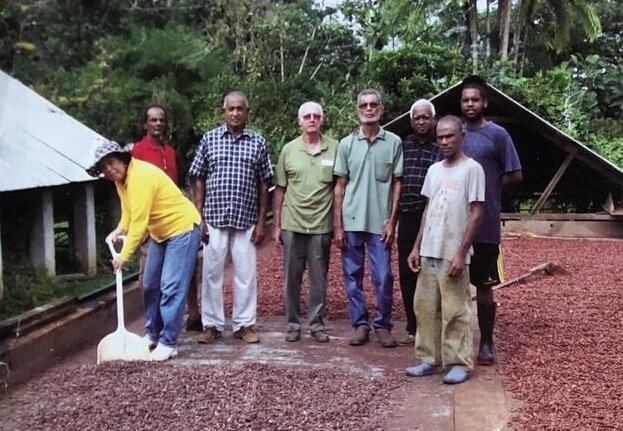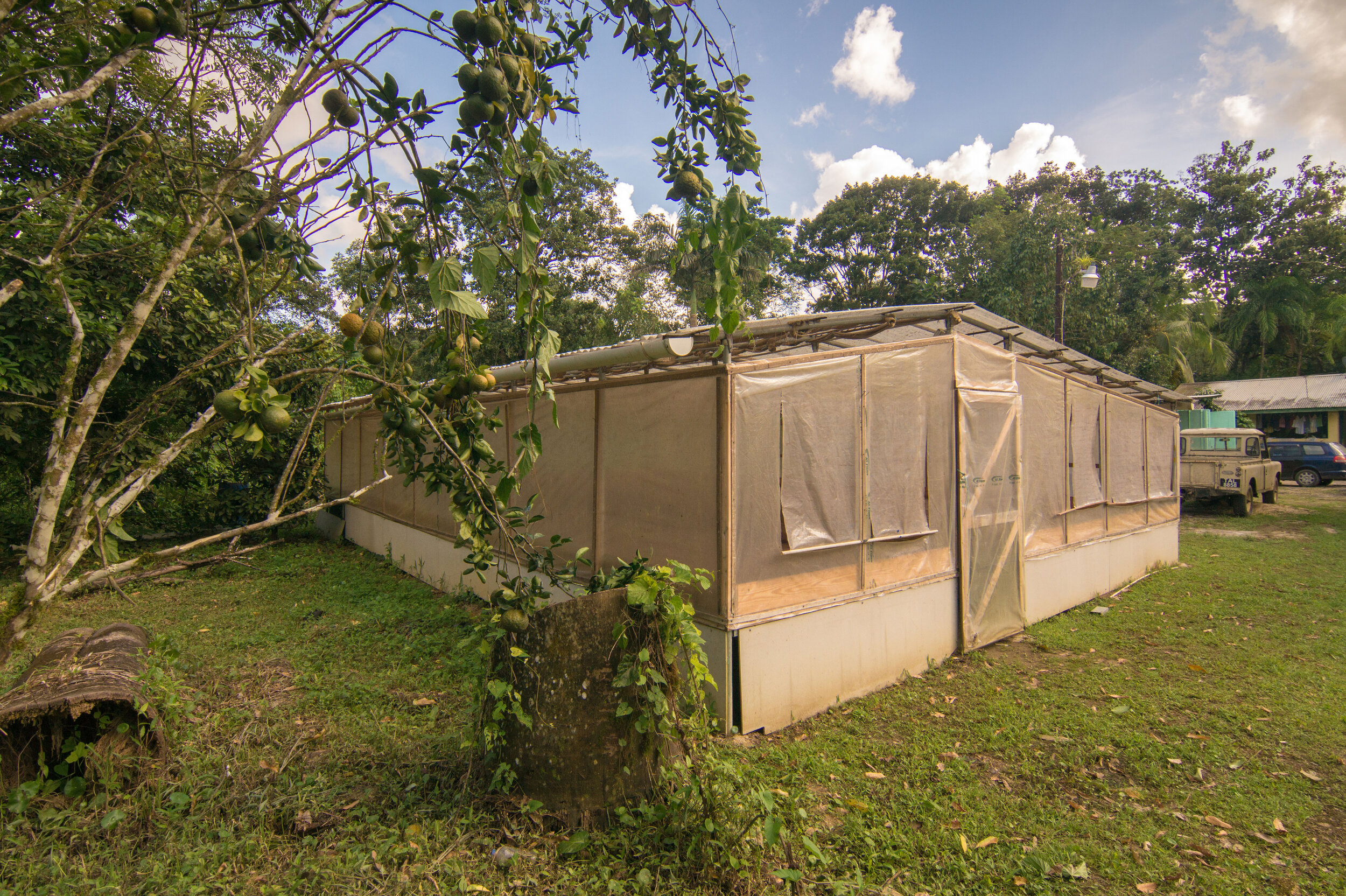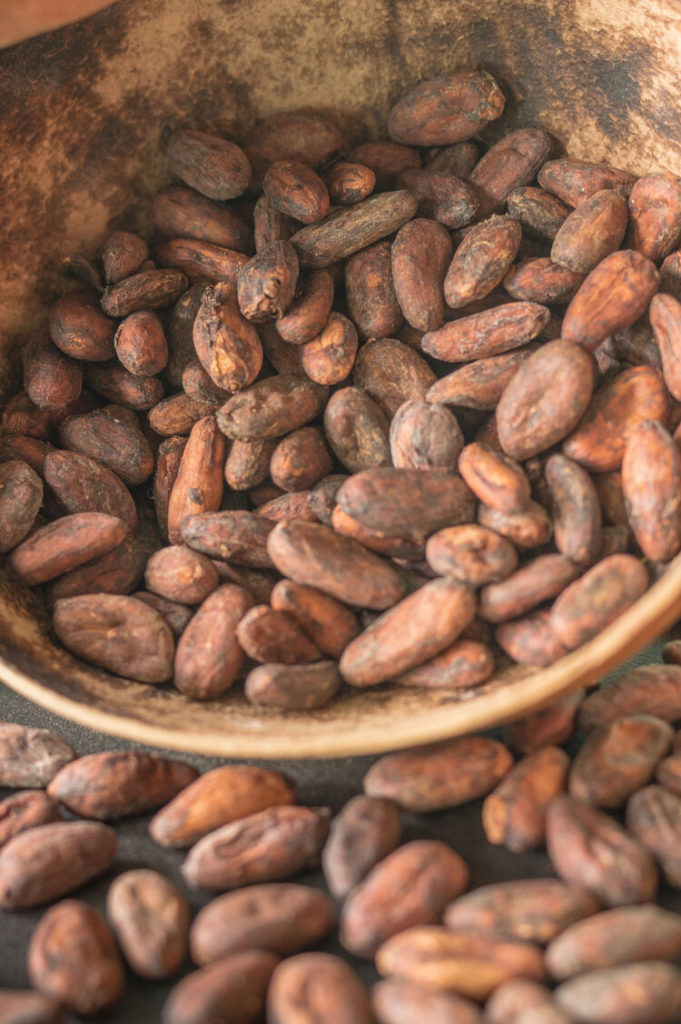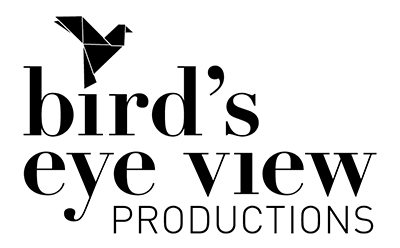Montserrat Cocoa Farmers Co-operative Society Limited (MCFCSL) – Preserving the Fine Flavours of Trinidad and Tobago
By Jonathan Stone | For Cocoa Research Centre, The UWI

In the beginning there were five farmers – Mr. Lee Sam, Mr. Caloo, Mr. Granger, Mr. Fullerton and Mr. De Verteil, who came together to establish the Montserrat Cocoa Farmers’ Co-operative in 2008. The five had a vision of a re-vitalized cocoa industry in their region of the Montserrat hills in Gran Couva – an exceptionally picturesque area of low-lying, densely forested hills where cacao beans had been planted ever since the late seventeenth century when Catalan Capuchin missionaries settled among the Amerindian peoples of Trinidad.
Mr. Lee Sam and the other founding farmers all shared in common – ownership of different parcels of cacao lands in the Montserrat hills and a love of the cocoa. Although they had developed successful careers in the city or other sectors of the local economy, the five were linked to the land through their parents and grandparents and had grown up listening to stories of the former glory days of the “golden bean”. One could say cocoa was most definitely in their blood.
At the time that the Co-operatives founders came together, the cocoa industry in Trinidad was a shadow of its former self. From its heyday before the 1920s, Trinidad’s cocoa production had slowly dwindled and by the 1950s much of the cultivation on the island had stopped, as workers left the area and established landowners sold up and started jobs in other industries in the cities.
The five farmers decided that by sharing knowledge and expertise, and establishing common facilities for processing the beans, they would stand a better chance of bringing the cocoa industry back to life. They wanted to put farmers first and give back to their local community, and at the same time restore the prestige once associated with the Montserrat cacao that is their heritage. Their first plan was to create their own fermenter or buying agency to counter the Cocoa Board’s unfavourable pricing systems – a vestige of the past colonial era. In their initial sale soon afterwards, the farmers successfully managed to increase the bidding price they got for raw fermented beans.
Since those early days, the Co-operative has gone from strength to strength. Membership has expanded almost tenfold and asking prices for beans have been consistently raised with production on an upward trajectory. The Co-operative has also been granted Rainforest Alliance certification for their ethical practices and is recognized as G.I. or special geographic indicator locally.
I first meet Mr. Lee Sam at San Antonio estate, a central location which serves as the Co-operatives headquarters and base of operations. “These are exciting times for Montserrat Cocoa and our Co-operative,” Mr. Lee Sam tells me. He has just come from a meeting with the Cocoa Research Centre in St. Augustine and plans are in the pipeline to apply for international Geographic Indicator status. Such certification would further enhance the reputation of their beans.

We are sitting in the cooperative office sampling some of the various cocoa products available through their partner stores. “In 2016 the Co-operative became the first organization in the Anglophone Caribbean to be granted Rainforest Alliance certification for their commitment to sound environmental and social practices,” he goes on to tell me.
Looking out of the office window one can see the traditional manual drying houses with their mobile roofing designed to protect the drying beans from rain. One can also see the splendid cocoa trees, with their bright yellow and orange pods, their distinctive foliage spreading out into the distance. The towering immortelle trees with crimson blossoms sway gently in the breeze and huge clumps of bamboo dot the sides of the waterways here and there. One or two majestic breadfruit and chataigne trees rise up out of the mass of cacao leaves, their fruit glistening bright green in the rain and sun. One can’t help but marvel at the beauty of it all, but also at the grand desig

In nature, cooperation and competition have always existed side by side. The cocoa plantation is no different. The young cacao seedlings, vulnerable to the scorching rays of the midday sun, must be sheltered by taller cassava or banana. These fast-growing species provide both shade to the immature plants and are a source of food or income to the young plantation as it gets on its feet. The plantation worker walks under the trees, pruning the cacao trees into more productive shapes and removing unwanted weeds that compete for sunlight, water and nutrients.
Other trees such as mangoes or avocados, are planted among the cacao and in turn provide shade and food. These other trees also break up the continuity of the cacao lines, thus reducing the spread of cacao-specific pests and diseases. When the cacao trees become fully-grown, towering cedars and immortelles replace the smaller shading plants; these tall trees are dual purpose, both species providing partial shade, the cedars also maturing into a valuable hardwood crop, the immortelles contributing nitrogen fixation of the soil. The whole system mimics a forest ecosystem with canopy shade trees, understorey and leaf litter on the floor. It is this diversity and the complementary nature of the differing elements that give the system its strength and resilience.
Likewise the Co-operative’s team members support each other and each member brings a unique skill set and experience to the table, whether it be agronomy, marketing or financial savvy. “There are retired teachers, investors and even former oil workers among our team,” Mr. Lee Sam tells me. “Strength in numbers allows us to hold out for better prices on the world markets, rather than give in to the first offer that comes along, as many small-scale farms are often forced to do in cocoa-producing regions elsewhere in the world.”

In terms of organisational structure, each member is allowed to purchase a set number of shares each year, but monetary investment is not the main driver behind their success. Rather it is the beans themselves that are their lifeblood. At the annual gala dinner and award ceremony, farmers are rewarded based on their production weights and there are also additional incentives such as the “Efficiency Awards” recognising farmers that have demonstrated the best farming practices and produced the most beans per acre of land. Often it is the smaller farmers and holdings that win such awards.

Since its inception, continuous cooperation between the Co-operative and local academics based at the Cocoa Research Centre (CRC), at the University of the West Indies, Trinidad have lead to a symbiotic partnership whereby the Co-operative gains valuable knowledge and expertise and in return provides the CRC with a living laboratory where the latest techniques and strains can be tested. The CRC was there offering advice when the five farmers initially decided to bypass the Cocoa Board and go it alone, and the CRC also provided training and help to procure equipment from abroad to set up the Co-operative’s first chocolate factory several years later.

Such co-operation, dedication and hard work have paid off. In August 2017, the Montserrat Cocoa Farmers Co-operative became the first local company to win Geographical Indication (G.I.) accreditation for their “Trinidad Montserrat Hills Cocoa”. This accreditation certifies that the beans produced from the Co-operative’s member estates are of an especially high quality specific to the growing region of the Montserrat Hills. These beans offer the unique fruity, floral and woody undertones that are prized by chocolatiers worldwide. As such, beans have now been exported to fine chocolate houses in Belgium, France, Switzerland and Japan.
Although the Co-operative’s rise over the past few years has been impressive, it has not been without its difficulties. In the past there was some opposition to their radical new approach from traditional interests along the supply chain. However by banding together and sharing their resources, the Co-operative members have managed to increase their strength in numbers and bring more value to the local economy and the farmers themselves. Since the dissolution of the National Cocoa Board in Trinidad and the establishment of the Cocoa Development Company, there has even been increasing support from local government, the Ministry of Agriculture and other government bodies.
“We are in the process of implementing the necessary productive strategies and establishing the infrastructure to add value to the supply chain from bean to bar and beyond.” Mr. Lee Sam boasts. He tells me that newer products such as cocoa butter, soaps and hand creams allow small-scale farmers to stretch their modest incomes.
“Although it is a challenging industry, I couldn’t see myself doing anything else.” Mr. Lee Sam confesses. “There is something almost sacred about the cocoa here and we are truly blessed with our location in the Montserrat Hills.” Meanwhile, the Co-operative is also increasing its training programs and cocoa-based tourism. There are hopes that within five to ten years a young farmer might well be able to picture themselves once more making a decent living from planting the cacao in these beautiful hills.


References:
“The History of Cocoa production in Trinidad and Tobago” by Francis L. Bekele
“The History of Cocoa in Gran Couva and Surrounding Areas” by Derek de Verteuil
“Cocoa, the Golden Bean – Cocoa and the Second Frontier (1870-1920)” by Bridget Brereton
Interview with Mr. Jude Lee Sam, Director and Founding Member of Montserrat Cocoa Farmers Co-operative Society Limited (November 2018)
“Gran Couva – Cocoa Haven, Chocolate Heaven” in Caribbean Beat, March 2018 ps.6-7
www.montserratcocoa.com
